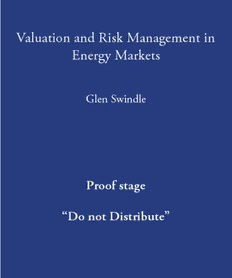
Valuation and Risk Management in Energy Markets PDF
Preview Valuation and Risk Management in Energy Markets
Valuation and Risk Management in Energy Markets Glen Swindle Proof stage “Do not Distribute” VALUATION AND RISK MANAGEMENT IN ENERGY MARKETS ValuationandRiskManagementinEnergyMarketssurveysthemechanicsof energymarketsandthevaluationofstructurescommonlyarisinginpractice. The presentationbalancesquantitative issuesand practicalities facingport- foliomanagers,withsubstantialattentionpaidtothewaysinwhichcommon methods fail in practice and to alternative methods when they exist. The material spans basic fundamentals of markets, statistical analysis of price dynamics, and a sequence of increasingly challenging structures, conclud- ing with issues arising at the enterprise level. In totality, the material has been selected to providereaderswith the analytical foundation requiredto functioninmodernenergy-tradingandrisk-managementgroups. GlenSwindleisthemanagingpartnerandco-founderofScovilleRiskPart- ners,aglobalprofessionalservicesandanalyticsfirmfocusedontheenergy and commodities sectors. He has held senior positions at Constellation Energy, where he ran the Strategies Group for the merchant energy busi- ness, and at Credit Suisse, where,as managing director,he was responsible forsignificantaspectsoftheNorthAmericanenergybusiness,runningstruc- turedtradingteams,andmorebroadlyasco-headofpowerandnaturalgas trading. Previously he held tenured positions at the University California– SantaBarbaraandCornellUniversity.Hecurrentlyholdsanadjunctfaculty position at New York University, where he lectures on energy valuation and portfolio management. He is also on the EnergyOversightCommittee fortheGlobalAssociationforRiskProfessionals’EnergyRiskProfessional Program and is a frequent speaker at panel discussions and webinars. He holds a Ph.D. in applied mathematics from Cornell University, an MSE in mechanicalaerospaceengineeringfromPrinceton,andaB.S.inmechanical engineeringfromCaltech. VALUATION AND RISK MANAGEMENT IN ENERGY MARKETS GLEN SWINDLE IndependentAnalyst 32AvenueoftheAmericas,NewYork,NY10013-2473,USA CambridgeUniversityPressispartoftheUniversityofCambridge. ItfurtherstheUniversity’smissionbydisseminatingknowledgeinthepursuitof education,learningandresearchatthehighestinternationallevelsofexcellence. www.cambridge.org Informationonthistitle:www.cambridge.org/9781107036840 (cid:1)c GlenSwindle2014 Thispublicationisincopyright.Subjecttostatutoryexception andtotheprovisionsofrelevantcollectivelicensingagreements, noreproductionofanypartmaytakeplacewithoutthewritten permissionofCambridgeUniversityPress. Firstpublished2014 PrintedintheUnitedStatesofAmerica AcatalogrecordforthispublicationisavailablefromtheBritishLibrary. LibraryofCongressCataloginginPublicationData Swindle,Glen. Valuationandriskmanagementinenergymarkets/GlenSwindle. pages cm Includesbibliographicalreferencesandindex. ISBN978-1-107-03684-0(hardback) 1. Energyindustries–Finance. 2. Commodityfutures. 3. Investments–Mathematical models. 4. Financialrisk. I. Title. HD9502.A2S95 2014 (cid:2) 332.644–dc23 2013027353 ISBN978-1-107-03684-0Hardback CambridgeUniversityPresshasnoresponsibilityforthepersistenceoraccuracyof URLsforexternalorthird-partyInternetWebsitesreferredtointhispublication, anddoesnotguaranteethatanycontentonsuchWebsitesis,orwillremain, accurateorappropriate. Contents Preface pagevii I IntroductiontoEnergyCommodities 1 1 Context 3 2 ForwardsandCarry 14 3 MacroPerspective 32 II BasicValuationandHedging 79 4 Risk-NeutralValuation 81 5 DynamicsofForwards 91 6 SwapsBooks 118 III PrimaryValuationIssues 137 7 TermStructureofVolatility 139 8 Skew 160 9 Correlation 187 IV MultifactorModels 221 10 Covariance,SpotPrices,andFactorModels 223 11 GaussianExponentialFactorModels 244 12 ModelingParadigms 258 V AdvancedMethodsandStructures 295 13 NaturalGasStorage 297 14 TollingDeals 335 15 Variable-QuantitySwaps 375 v vi Contents VI AdditionalTopics 403 16 Control,RiskMetrics,andCredit 405 17 Conclusions 432 Appendixes 445 A Black-76andMargrabe 447 B PortfolioMathematics 455 C GaussianExponentialFactorModels 458 D CommonTradables 464 Bibliography 473 Index 479 Preface In the summer of 1998, I was working at a hedge fund in Bermuda and contemplating returning to the United States, the plan being to continue working in a fixed-income quantitative role of some sort. Fortunately, I suppose,aformerstudentofmineatCornell,DanaThorpe,stronglyencour- aged me to look into the energymarkets, particularly electricity. Dana had worked in this area for a few years and described the modeling and risk- management state of affairs as being in a nascent stage and largely virgin territory. As it turned out, several shops had already been systematically build- ing very solid analytics, architected by some of the now best-known minds in the business, and academics were becoming increasingly interested in energy.However,despitetheconsiderableeffortsofregimentsandbrigades of researchers, including groups that I have had the opportunity to to run over the years,Dana’s assessmentmade fifteen yearsago feels disturbingly closetothetruthevennow. My first significant tour of duty in energy was at Constellation Power Source (CPS), at the time the name of the merchant arm of Constellation Energy. Initially, CPS was a joint venture between Goldman Sachs and Baltimore Gas & Electric (BG&E). Perceptions of hubris aside, Goldman management was shrewd enough to know that when entering a business as peculiarandcomplexaselectricity,itmightnotbeabadideatopartnerwith people who have been working within the context of the physical system for decades. In many respects this collaboration was successful, with first- rate trading systems and risk-management experience afforded by Gold- man coupled with the seasoned skepticism and engineering knowledge of BG&E. Whilepersonalitiesandvaluesystemsconvergedovertheyears,astriking featureoftheoperationwastheyawninggapbetweenthevaluationsystem (whichis,infact,quiteimpressive)andtherealitiesfacingtheteamsrunning the assets. The risk system could accommodate the litany of conventions vii viii Preface of physical and financial settlement of any commodity, notably the hourly or subhourly calculations that are required. Forward valuation was also extremelyflexible,providedthattransactionswererepresentedasderivative constructswithalltheimplicitassumptionsunderpinningcompletemarkets and risk-neutral valuation. This is true of most risk systems, both commer- cialandin-house.Transactionsmustbeboileddowntoarepresentationthat requiresforwardcurves,impliedvolatilities,impliedcorrelations,andallthe otherusualinputs,eachofwhichispresumedtobetradableinsomefashion. The problem that confronted portfolio managers, and does to this day, is that many commonly traded structures in energy involve risks that trade so rarely and in such small size that market activity is at best an indication of how others are assessing the risk. At worst, such can be outright disin- formation to confuse market participants in advance of large transactions or auctions. In such situations, any notion of market completenessis moot. Extrinsic value as ascertained in idealized settings simply cannot be cap- tured.Structuresthatlooklikequantoscannotbehedgedwhenonelegdoes nottradeatall. Otherwaysofthinkingaboutvaluationandriskarerequired. In the course of what follows, much of the standard liturgy on valuation of energy structures will be described in full detail. However, substantial attention also will be paid to the ways in which common methods fail and to alternative methods when they exist. In some situations, the conclusion will be that researchers and practitioners simply do not yet know how to properlyhandlesometransactions.Ratherthanbeingbadnews,thisiswhat makes the field of energy trading and structuring particularly vibrant, even afterseveraldecadesofthought–openproblemsabound. This book is descendantfrom a sequenceof lectures that I started giving eachspringatNewYorkUniversityin2008.IwasworkingatCreditSuisse at the time, and the bankaccommodatedandsupportedthe effort overthe followingyearstohavepractitionersinteractingdirectlywithfinancialengi- neeringstudents,no smallnumberofwhich Ihaveseenon the desksatthe bank in subsequent years. Ultimately, these lectures evolved into a collec- tionofmaterialthatwillhopefullyproveusefulfor“quantitativetypes”with acommercialorientationenteringthebusinessandjoiningatradingdesk. This book is structured in six parts . Part I is an overview of some of the distinguishing features of energymarkets and a survey of important funda- mental and econometric attributes of the core markets discussed – crude oil and refined products , natural gas, and electr ic ity. Part II covers basic “zeroth-order” valuation before moving into a more detailed analysis of the empirical features of price dynamics and the implications for manag- ing swapsbooks. While the content of the firsttwo parts is clearly oriented toward “stylized facts” about markets, modeling in the absence of such informationisnotagoodidea.
